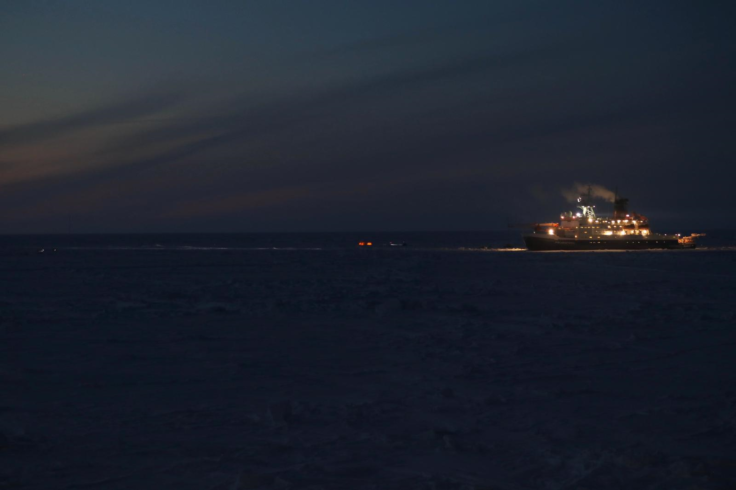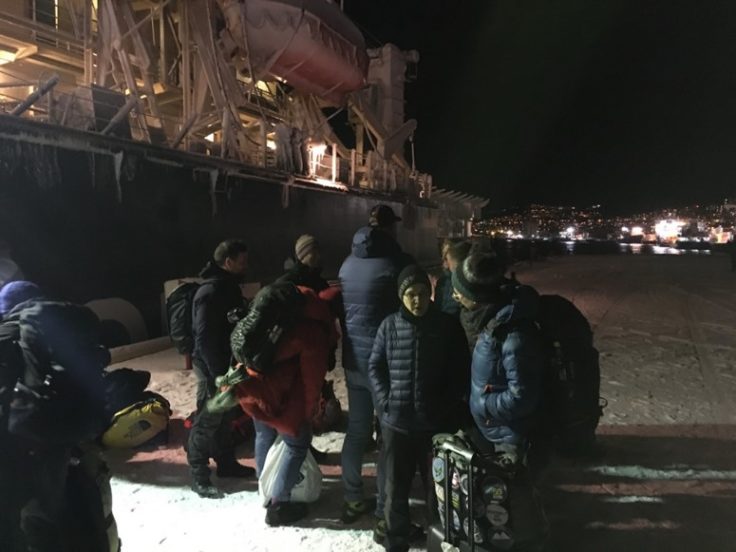MOSAiC Blog: Approaching RV Polarstern
26 February, 2020
Dr Markus Frey is on board Russian icebreaker Kapitan Dranitsyn, making the final approach through the Arctic sea ice to join the MOSAiC expedition on board RV Polarstern. German research icebreaker RV Polarstern is staying close to the north pole for a full year to enable the closest ever look at the Arctic to better understand global climate change. Markus will be using the SSAASI-CLIM laboratory to research the interaction between sea ice and atmospheric particles.
Wednesday, 26 Feb 2020
88 deg 24’36″N 54 deg 35’46″E, on board the Russian icebreaker Kapitan Dranitsyn, about 32 km away from RV Polarstern
Air temperature -29 deg C/ wind speed 15 m s-1
Less than a full marathon distance is separating us now from RV Polarstern. Twilight is now frequently colouring the horizon in magical red and yellow in anticipation of the first sunrise. The highlight of the day was a first transfer by helicopter of a few people and some cargo between the two ships with good flight conditions before noon. The aim remains to go side by side with RV Polarstern in the next day or two to achieve a full handover.
In the late evening all of a sudden many of us were rushing to the bridge to marvel at a unique view: two bright lights at a distance, it is RV Polarstern, finally we can see her!

Until now we have spent 31 days on board the Kapitan Dranitsyn travelling North for over 3 weeks through the pack ice to reach RV Polarstern. From the beginning it was clear that the changeover between Legs 2 and 3 of MOSAiC by conventional icebreaker would be the hardest one throughout the year, with likely delays due to winter sea ice conditions. Even so, almost no one expected to spend this amount of time just getting to our destination. Spirits and motivation are high to relieve our MOSAiC colleagues from Leg 2, and to start our scientific work on the ice floe and on the ship in time for polar sunrise.

The days on Kapitan Dranitsyn went by with scientific seminars presenting to each other our science projects and discussing cross-disciplinary science questions no team would be able to answer on its own. For example, we discussed the measurement of fluxes of greenhouse gases such as carbon dioxide (CO2) or methane (CH4) between ocean, ice and atmosphere, which are important for our understanding of the build-up of heat-trapping gases in the atmosphere and the recent warming observed the Arctic and elsewhere. Another topic of debate was the coordination of measurements on and around an opening lead, an event which is expected to occur more frequently in late spring and early summer with potential huge impact on the local structures of the near-surface atmosphere and ocean as well as the ecosystems in ice and water.
There was also ample time to organise ourselves to tackle efficiently scientific and logistic tasks: the handover with Leg 2 colleagues, polar bear guard shifts, our weekly schedule of work on the ship and ice floe, sampling of snow and ice. Our daily routine between meals was livened up by ice observations from the bridge, visits of the sauna or gym, and the occasional movie evening. Looking forward to start work on the ice and for the sun to come back.
26 Feb 1894, Polar explorer Fridtjof Nansen writes in his diary: We are drifting NE. A tremendous snow storm is going on and it is howling in the rigging, whistling over the ice, and the snow is drifting so badly that a man might be lost in it quite near at hand. I look forward to spring and summer, in suspense as to what change they will bring.
Read the previous MOSAiC blog post here.